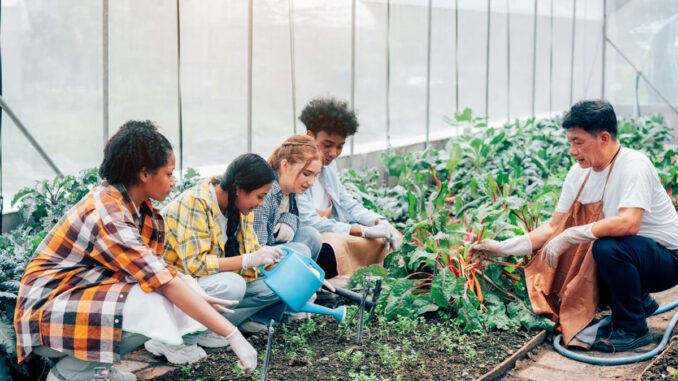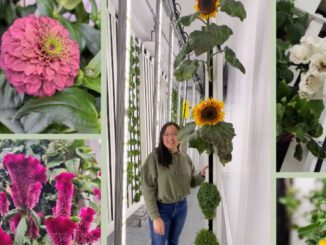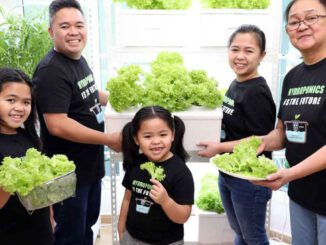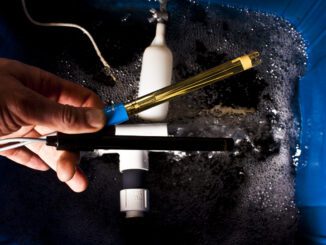
Just Add Water: How The Gardens of The Future Are Transforming Food Today
Hydroponic Agriculture | Alex Caspero |
It’s projected that humans must increase worldwide food production by roughly 70% by 2050 to meet the caloric needs of 10 billion people. Through traditional agricultural practices, this would require people to convert 593 hectares of land for new food production, about double the size of India.
Traditional agriculture’s resource expenditure is astronomical when accounting for land, water, fertilizer, and pesticides. Currently, 38% of the earth’s non-frozen land is used for growing food.
Worldwide, 70% of freshwater goes towards agricultural production, mainly due to the disparity in resources needed to grow food for animals and unsustainable irrigation practices.
Efficiency is critical to feeding a growing planet. Hydroponic farming, where plants obtain nutrients directly from water-based solutions, may be part of the solution to our planet’s unfolding agricultural crisis.
A More Sustainable Option
Conventional farming is limited by land, soil health, suitable terrain, seasonality, and weather conditions. Conversely, indoor farming allows for year-round crop production with fewer natural resource requirements.
Hydroponics can grow anywhere — literally, anywhere. It’s weather and climate-proof farming, meaning that floods, droughts, and other natural disasters can’t wipe out an entire season of crops. In 2019, desert locusts ruined the food supply of 25 million people, demolishing a year’s worth of work. Moving farms indoors almost eliminates crop vulnerability to bugs and weather.
Instead of soil, seeds are planted in a growth medium, from coconut husks to hemp fiber. Soil-free farming minimizes the need to control unwanted bugs and weeds, reducing the need for pesticides and herbicides. Rather than getting light from the sun, plants receive energy from LED lighting specifically tailored to plants’ energy needs.
Moreover, hydroponic farming is more sanitary. Consider the recent recalls of romaine lettuce in 2018 and 2019 from E.coli contamination, with an estimated economic impact of $276–343 million.
Hydroponics also conserve water by using recirculating systems, significantly reducing water wastage compared to conventional farming. This so-called “closed loop” system is the heart of what makes hydroponics sustainable.
Jacob Pechenik, Co-Founder and CEO of Lettuce Grow says, “A huge benefit of hydroponics is their recirculating nature. It not only helps optimize plant growth by regulating temperature and nutrient concentration but also leads to a great amount of water conservation because any water not taken up by the plants roots is captured and recirculated throughout the system.”
This reduces water consumption by an impressive 98% compared to traditional gardening. These systems not only recycle the water but the nutrients too. Anything not absorbed by the plants the first go-around is recirculated.
“This is a great benefit when contrasted with nutrient runoff that can come with traditional farming systems,” notes Pechenik.
Some crops work better than others. Hydroponic superstars include vining crops like tomatoes, cucumbers, peppers, leafy greens, herbs, and strawberries.
Most agricultural staples like soybeans, peas, root vegetables, and tropical fruit cannot be grown commercially using these methods. That’s because they don’t achieve the same yields as traditional farming and cannot be priced competitively.
The Urban Problem
Consider a typical farm — an average of 445 acres in the U.S. — with crops as far as the eye can see. Now, consider vertical farming, where food grows on trays or hanging modules outdoors or in a climate-controlled, indoor facility. Like skyscrapers, the towers grow up, allowing more plants to be densely packed upon one another.
Growing food indoors using vertical hydroponic farming allows food to be grown year-round, anywhere, in small spaces. Produce could then be delivered within hours of harvest.
Lettuce, for example, doesn’t have to sit inside a refrigerated truck for days as it makes its way across the country. Now, vegetables can be bred for flavor rather than storage concerns.
Amazon CEO Jeff Bezos and Alphabet Technical Advisor Eric Schmidt agree. Both billionaires are investors in hydroponic startups intending to transform farming and provide fresh food access to urban dwellers, where adjacency to hundreds of acres of land to grow enough food isn’t possible.
With a focus on individual household scaling, numerous backyard (or indoor) hydroponic gardens are marketed toward consumers, giving access to renters or those lacking enough land for traditional gardening. Pechenik’s product, Lettuce Grow, allows the growing of 36 plants in just 4 square feet. Fresh pesto, anyone?
“Where hydroponics truly shines is in its ability to democratize access for homegrown pesticide-free food… while offering predictability and significant time and cost savings compared to traditional methods like raised beds,” says Pechenik. Indoors or out, hydroponics empowers anyone to cultivate fresh produce, fostering inclusivity and sustainability.
Closing The Loop on Food Access
Companies focused on equitable food systems are laser-focused on this new technology. Hydroponic greenhouse farming enables companies like Gotham Greens to grow high-quality produce 365 days a year using less land, water, and energy while producing less pollution and food waste.
The lettuce purveyor started as a single rooftop greenhouse in Brooklyn, N.Y., and has grown to be one of North America’s largest greenhouse leafy greens producers. These controlled environments allow them to grow year-round in climates like Denver, New York, or Chicago.
Viraj Puri, Co-Founder and CEO of Gotham Greens says, “By building enough scale and efficiency in our greenhouse operations, we can provide our products at a price parity to organic produce.”
More gardens in more places can influence the ever-widening wealth gap in healthcare. The Centers for Disease Control and Prevention reports only 1 in 10 Americans consume the recommended amount of fruits and vegetables, with lower-income individuals consuming the fewest servings. Adequate produce consumption supports immune function and prevents chronic disease.
The environmental advantages of hydroponic food production may be just as significant as the access to fresh fruits and vegetables these farms can bring. Puri notes, “By providing more access to fresh, sustainably grown produce, consumers can follow a more balanced diet comprised of fresh vegetables and fruits for a healthier lifestyle.”
Original Article: https://wealthofgeeks.com/hydroponic-gardening-today/



